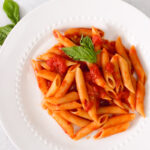Pasta with Italian Tomato Sauce (Sugo di Pomodoro)
Authentic Italian Tomato Sauce (Sugo di Pomodoro) -An authentic Italian pasta sauce recipe made totally from scratch! This tomato sauce is so easy and is done with just a few simple steps. All you need are some fresh or canned tomatoes, garlic, basil, and olive oil.
Servings: 4
Calories: 96kcal
Equipment
Ingredients
- 3 Tablespoons extra-virgin olive oil
- 2 garlic cloves minced
- 1 can 28 ounces whole peeled San Marzano DOC tomatoes
- 1-2 teaspoons sea salt
- ½ cup fresh basil
- Italian parsley chopped optional
- ¼ teaspoon red-pepper flakes optional
- To Serve:
- ¾ lb to 1 lb of cooked pasta of your choice I used penne
Instructions
- Heat oil: In a large saute' pan or medium saucepan, heat olive oil over medium-high until it's shimmering.
- Add some garlic: Add garlic and cook until fragrant (no more than a minute, or it will brown).
- Tomatoes: Add in the tomatoes and the juice(I break up the tomatoes with my hands, removing the hard end before adding to the sauce).
- Bring to a boil: Bring the sauce to a boil and use a wooden spoon to stir, breaking up the tomatoes while they're cooking.
- Lower heat: Once the sauce comes to a boil for a few minutes, lower heat to a simmer.
- Season sauce: Season with the salt, and let the sauce cook and thicken.
- Check the consistency of sauce: If it's getting too thick, add a little bit of water (start with a ¼ cup).
- Add fresh basil: Finally, stir in the fresh basil and stir to combine (and parsley, if you're using).
- Simmer sauce: Let sauce simmer for 20 minutes total. Check the salt and add more if needed. Add the fresh basil and stir to combine. Add hot pepper flakes, if you like it spicy.
- Cook the pasta: Boil large pot of salted water. Add in the pasta and cook according to the time on the box. Strain pasta just before al dente, reserving some of the pasta cooking water.
- If the sauce seems too thick, add some of the pasta water.
- Add cooked pasta to sauce: Add the strained pasta to the sauce and turn heat back up to medium-medium-high. Let it cook together for a minute with the sauce to combine.
- Serve the pasta: Add in some more chopped fresh basil for serving. Plate up the pasta and ENJOY!
Nutrition Disclaimer
Please keep in mind that the nutritional information presented below is an approximation and may vary depending on the exact ingredients used.
Notes
Substitutions & Variations for easy Italian sauce:
Tomatoes:- Substitution: If you don't have San Marzano tomatoes, you can use any type of canned whole tomatoes. For a fresher version during tomato season, use ripe, fresh tomatoes that have been blanched and peeled.
- Variation: Add some sun-dried tomatoes for a deeper tomato flavor, or try fire-roasted tomatoes for a smoky note.
- Substitution: If you don't have fresh basil, try dried basil (use about ⅓ of the amount since dried herbs are more concentrated).
- Variation: Incorporate other Italian herbs like oregano or thyme to diversify the flavor profile. Mix in some fresh Italian parsley for added freshness.
- Substitution: Instead of red pepper flakes, use a pinch of cayenne pepper or a few dashes of hot sauce to control the heat level.
- Variation: For a non-spicy version, simply omit the red pepper flakes, or for an aromatic kick, add a bit of smoked paprika.
- Substitution: If you prefer a lighter version, you can reduce the amount of olive oil or substitute it with a lighter oil like avocado oil.
- Variation: For an enriched flavor, try using a bit of butter along with the olive oil.
- Substitution: If you're out of fresh garlic, you can use ½ teaspoon of garlic powder as a substitute for each clove.
- Variation: Roast the garlic prior to adding it to the sauce for a milder, sweeter flavor.
- Substitution: If the sauce is too acidic, add a pinch of sugar to balance it out.
- Variation: Add a splash of balsamic vinegar for a subtle sweetness and depth.
- Variation: Instead of pasta, serve the sauce over spiraled vegetables like zucchini or squash for a low-carb option, or use it as a base for a casserole or as a topping for grilled meats.
Nutrition
Calories: 96kcal | Carbohydrates: 1g | Protein: 0.2g | Fat: 11g | Saturated Fat: 1g | Polyunsaturated Fat: 1g | Monounsaturated Fat: 8g | Sodium: 584mg | Potassium: 18mg | Fiber: 0.1g | Sugar: 0.04g | Vitamin A: 195IU | Vitamin C: 1mg | Calcium: 9mg | Iron: 0.2mg
Tried this recipe?Mention @savoringpasta or tag #savoringpasta!
